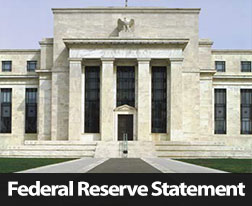 According to statement issued at the conclusion of today’s Federal Open Market Committee meeting, committee members decided against raising the target federal funds rate. Mixed economic conditions, slower economic growth in the 4th quarter and low inflation contributed to the decision against raising rates. The target federal funds rate was raised in December to a range of 0.25 to 1.59 percent after remaining at 0.00 to 0.25 percent for several years. While rising fed rates were expected to cause a hike in mortgage rates, mortgage rates fell after December’s rate hike.
According to statement issued at the conclusion of today’s Federal Open Market Committee meeting, committee members decided against raising the target federal funds rate. Mixed economic conditions, slower economic growth in the 4th quarter and low inflation contributed to the decision against raising rates. The target federal funds rate was raised in December to a range of 0.25 to 1.59 percent after remaining at 0.00 to 0.25 percent for several years. While rising fed rates were expected to cause a hike in mortgage rates, mortgage rates fell after December’s rate hike.
Committee Cites Mixed Data in Decision
While labor conditions and housing markets continue to improve, FOMC members said that further improvement in labor markets and achieving the medium term goal of inflation influenced the committee’s decision not to raise rates. The Federal Reserve has a dual goal of achieving maximum employment and 2 percent inflation. While labor conditions continue to improve, the Committee wants to see further improvement. The inflation rate has stubbornly stayed below 2 percent and lower energy and non-energy import prices caused the inflation rate to fall further in recent weeks. The Fed also downgraded its reading of household spending and business investment growth from “strong” to “moderate.”
FOMC members consider global economic and financial conditions as well as trends and developing news affecting domestic economic and financial developments. Wednesday’s statement emphasized that constant monitoring and analysis of financial and economic readings are significant in monetary policy decisions. Analysts noted that recent economic developments including slowing economic growth in the US and China, along with resulting turbulence in financial markets likely contributed to the Fed’s decision not to raise the federal funds rate.
FOMC Says Policy Decisions to Remain “Accommodative”
Members of the FOMC do not expect marked economic improvement in the short term and said that they expect Fed monetary policy to remain accommodative “for some time.” This suggests that rapid rate hikes are not likely to occur in the near future; the Fed’s commitment to gradual rate increases is expected promote further improvements in labor markets and hold down borrowing rates for consumer credit and mortgages.
The Committee’s vote not to increase rates was unanimous. The next FOMC meeting is set for March 15 and 16. In the meantime, Fed Chair and FOMC Chair Janet Yellen is slated to testify before Congress about the economic outlook on February 10 and 11.
 Last week’s scheduled economic reports included the NAHB Housing Market Index, Housing Starts, FOMC statement and Fed Chair Janet Yellen’s press conference. In addition to weekly reports on jobless claims and mortgage rates, inflation reports were also released.
Last week’s scheduled economic reports included the NAHB Housing Market Index, Housing Starts, FOMC statement and Fed Chair Janet Yellen’s press conference. In addition to weekly reports on jobless claims and mortgage rates, inflation reports were also released. Last week’s scheduled economic releases included reports on job openings, retail sales and consumer confidence in addition to usual weekly releases on mortgage rates and new jobless claims. The details:
Last week’s scheduled economic releases included reports on job openings, retail sales and consumer confidence in addition to usual weekly releases on mortgage rates and new jobless claims. The details:
 Last week’s scheduled economic news was sparse due to no scheduled releases on Monday and the Veterans Day Holiday on Wednesday. A report on job openings was released on Thursday along with regularly scheduled weekly reports on jobless claims and Freddie Mac’s report on mortgage rates.
Last week’s scheduled economic news was sparse due to no scheduled releases on Monday and the Veterans Day Holiday on Wednesday. A report on job openings was released on Thursday along with regularly scheduled weekly reports on jobless claims and Freddie Mac’s report on mortgage rates. A number of economic reports released last week indicate mixed economic progress. The 20-City Home Price Index released by S&P Case Shiller showed that August home prices rose, but New Home Sales dropped in September. The Federal Open Market Committee of the Federal Reserve indicated that it may reserve the target federal funds range at its next meeting in December.
A number of economic reports released last week indicate mixed economic progress. The 20-City Home Price Index released by S&P Case Shiller showed that August home prices rose, but New Home Sales dropped in September. The Federal Open Market Committee of the Federal Reserve indicated that it may reserve the target federal funds range at its next meeting in December. The National Association of Home Builders (NAHB) / Wells Fargo Housing Market Index reported that home builder confidence rose by one point to a reading of 62 for September. This was the highest reading since November 2005, when the NAHB reported a reading of 68 for home builder confidence. Any reading above 50 indicates that more builders are confident about housing market conditions than those who are not.
The National Association of Home Builders (NAHB) / Wells Fargo Housing Market Index reported that home builder confidence rose by one point to a reading of 62 for September. This was the highest reading since November 2005, when the NAHB reported a reading of 68 for home builder confidence. Any reading above 50 indicates that more builders are confident about housing market conditions than those who are not. A short week after the Labor Day Holiday provided a slack schedule for economic news. Bloomberg reported that residential investment for the second quarter of 2015 represented 3.34 percent of the Gross Domestic Product. Compared to the long-term average reading of 4.56 percent, analysts said that the Q2 15 reading suggested pent-up demand in the housing market that could help propel the economy through any setbacks that could occur when the Fed raises rates.
A short week after the Labor Day Holiday provided a slack schedule for economic news. Bloomberg reported that residential investment for the second quarter of 2015 represented 3.34 percent of the Gross Domestic Product. Compared to the long-term average reading of 4.56 percent, analysts said that the Q2 15 reading suggested pent-up demand in the housing market that could help propel the economy through any setbacks that could occur when the Fed raises rates.